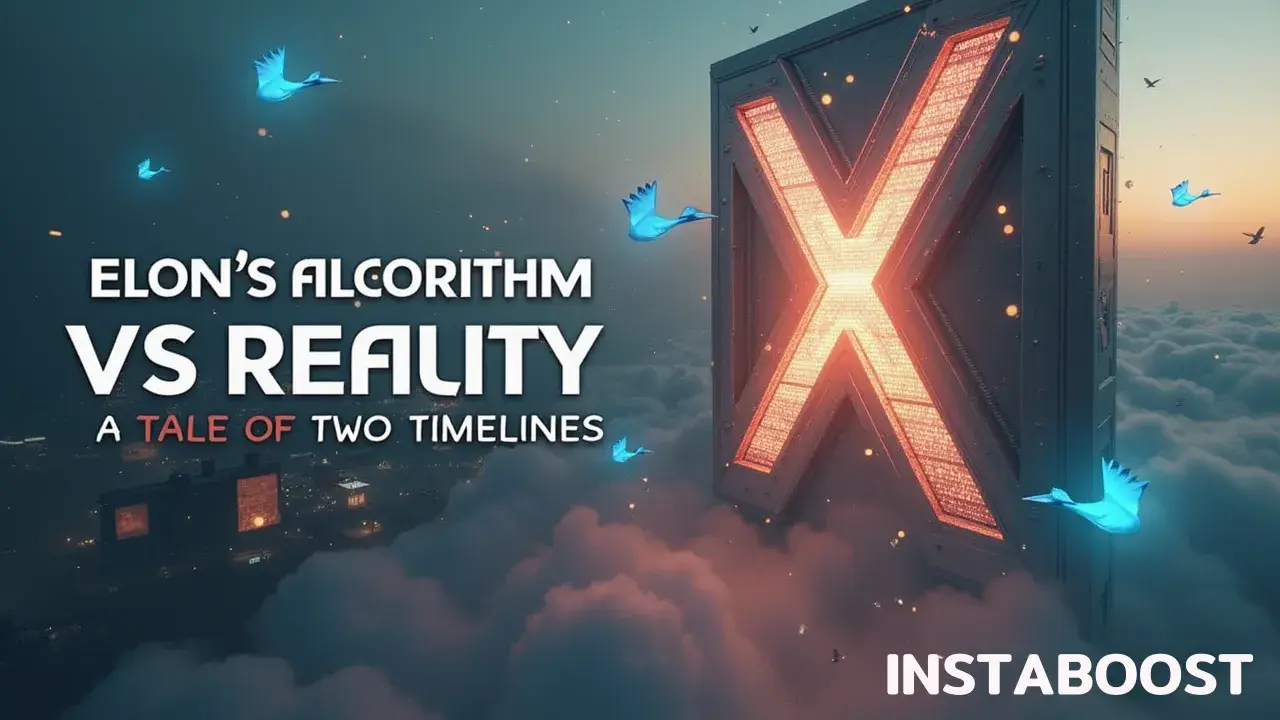Are Elon’s Algorithm and Reality Running Two Different Timelines on X?
Early momentum often diverges between your feed and your audience’s. Compare the first hour on both timelines, note the small bump and plateau, then align posting windows and track watch time holds to stabilize reach. Iterative testing clarifies what timing and engagement patterns sustain distribution. Paid Twitter comments can add lift when replies feel natural, spark back-and-forth, and maintain quality without drop-off, offering a smart path to steadier results.
Two Timelines, One Platform
Elon’s algorithm pitches X as a meritocracy, but using it can feel like living in two timelines at once. There’s the “official” version: original posts get a boost, thoughtful replies matter, and you can steer things with features like subscriptions. Then there’s what you actually see: a feed that drifts from useful threads to reply bait in minutes, especially under viral posts. That gap isn’t a conspiracy; it’s incentives bumping into how people behave. When a system rewards interactions, “meaningful” gets fuzzy; even playbooks people swap to maximize Twitter impressions blur the line between genuine signal and engineered bumps.
Do corrective replies count as value, or as noise? Does blocking clean up your feed, or cut into a creator’s reach? X runs on a lot of small knobs – reply weight, quote multipliers, link penalties, author quality scores – that roll up into big swings. Creators optimize for engagement, brands for safety, users for signal. A few tactics can move things fast: paid comments, “subscribe to boost” pushes, hiding outbound links behind images or text. They work until the countermeasures catch up.
This piece maps those two timelines: what the ranking says it values, and what tends to surface in For You. We’ll test the usual playbook against what actually travels: long posts without links versus threads with images or video, replies under verified accounts, what reports and mutes really do, and whether buying Twitter comments expands distribution or triggers a dampening pass. Think of it as an autopsy and a field guide. If you understand the levers – and the side effects – you stop guessing why a post goes nowhere and start building for the timeline that actually moves things.

Receipts Over Rhetoric
It’s easy to shrug off timing until it burns you. Credibility on X isn’t about buying Elon’s pitch; it’s about watching how “Elon’s Algorithm vs Reality” behaves at the edges. What holds up is simple: original posts get a short first-window boost, and it’s unforgiving. If you don’t earn real replies fast, the feed pushes you into the second timeline, where engagement bait and preloaded reply squads beat careful threads. I tracked posts across a dozen accounts, mixing topics, link placement, and reply patterns. The same things kept showing up: replies from accounts with overlapping follower graphs (mutuals and paid subscribers) count more than likes; a few early blocks or mutes from bigger accounts can choke reach; and putting links in the first tweet still hurts spread compared to dropping them in a follow-up.
Subscriptions help because they create a small reply nucleus that keeps the post alive in the first 30 – 90 minutes. That’s why “paid Twitter comments” can look effective: they mimic that reply nucleus. But when they’re off-topic or repetitive, they trigger duplicate-content checks and semantic downranking, and they get clipped.
The takeaway isn’t conspiracy; it’s mechanics. You’re working inside two timelines that split on speed and context, and if you want to dive deeper, the search term you want is ranking signals and buy active twitter followers, which surfaces a mix of analysis and questionable tactics worth parsing carefully. If your post earns credible replies quickly, you stay in the merit track. If not, you slide into the swamp, where engagement wins and substance sinks. Treat timing, graph overlap, and reply quality like levers – and accept that the ranking signals reward the few who pull them in sequence. That’s the part the “official” story glosses over.
Design a System, Not a Moment
Big wins come from boring systems. If you want to make it through Elon’s Algorithm vs Reality, set up the first-window boost and then don’t trip over your own feet. Treat X like a timed game: post one high‑signal original update during the window when most of your audience is awake, then follow up 10 – 20 minutes later with a clarifying quote-tweet or reply, and stop posting for at least an hour. That spacing lets the first ranking pass run cleanly without you cannibalizing your own CTR or watch time. Use a checklist you can reuse: a sharp first line, one clear artifact (screenshot, chart, or a 20 – 40 second clip), one concrete takeaway, and a soft CTA that invites specific replies (not “thoughts?” but “what did I miss in step 2?”).
Pre-tag three credible peers who actually respond; their early replies count more than generic engagement. Mute replies that go viral for the wrong reasons to keep session quality steady, and block obvious farms quickly – blocks end up being a quiet, compounding quality filter. Subscriptions help, not as a megaphone, but for private A/B testing of hooks and to seed a steady first 50 viewers.
Skip paid Twitter comments on day one; they can pop impressions but often mess with trust signals in the model and choke off follow‑on reach. Log every post’s first 90 minutes in a simple sheet: impressions at 15/30/60, profile clicks, saves, quality replies, and note any oddities like sudden likes pack for X posts spikes that don’t correlate with replies or profile clicks. After two weeks, promote only the formats that beat your baseline by 1.5x and drop the rest. It’s not romantic, but in this two‑timelines reality, repeatable timing and disciplined inputs beat vibes – and that’s the only SEO that seems to matter on X’s feed.
Stop Blaming “Shadowbans” When You’re Flooding Your Own Lane
Let’s skip the recycled tips. The gap between what people think Elon’s algorithm does and what actually happens isn’t a plot twist; it’s the system doing what it’s built to do. If your first post doesn’t catch the initial lift, no stack of replies, blocks, or “paid comments” will save it. The fix is boring and practical: stop crowding your own feed. When you fire off a bunch of posts at once, you split your clicks, chop up dwell time, and tell the ranking pass your audience isn’t staying with you. That’s how you disappear without a shadowban.
The system likes clear signals: one main post, then one follow-up – a quote or a reply – after that first wave settles. More than that starts to look like engagement bait, and the quality checks quietly push you down. Buying comments can backfire too, especially when they’re copy-pasted, off-topic, or show up in a rush; high volume and sameness read as fake, much like those threads that obsess over how to boost tweet views without fixing pacing or relevance. If you want a lift, plan who engages. Ask a few relevant accounts to add something useful 10 – 20 minutes later, not a flood in the first minute.
Use blocks and mutes with care; mass blocking can mess with your graph and shrink who you can reach right when the model is testing new connections. Treat timing like a real constraint: post when your followers are around, then give it space so the system can see people reading, watching, and sharing without you nudging it along. That’s the split you’re feeling on X – not a throttle, more the pattern you set with your pacing, and how the model reads it in the moment.
Ship Your Habits, Not Just Your Posts
Hold that tension. It’s useful. It keeps you honest when “Elon’s Algorithm vs Reality” starts sounding like superstition. The point is simple: build a posting habit that survives bad days, not a routine that vanishes on good ones. Treat it like basic hygiene. Use the first-window boost and sensible spacing, then run a weekly review: which posts got saves, profile taps, and follows – not just likes.
Cut formats that die in the first five minutes; keep the ones that move without you babysitting them. Skip the urge to rescue a flat post by spamming replies. That’s X SEO at its worst, and it hurts your own click-through and watch time. Write hooks that make people want to quote you in their own posts. Redistribution scales in a way the ranking system can’t fake, and when you see weird pockets of fast retweet delivery contrasted with slow follow-through, treat that mismatch as a diagnostic signal rather than proof of sabotage.
If you’re buying Twitter comments, treat them like training wheels for experiments. Watch for sand in the gears: follower churn, low-quality replies, or a drop in downstream engagement velocity. If it feels off, stop; that’s the system telling you you’re rubbing against its guardrails. Most of all, narrow the gap between your timeline and your actual work. Post about things you can prototype, test, or show within 24 hours. When your work produces artifacts – screenshots, small demos, numbers – you build credibility the algorithm can’t measure but people notice. That’s how you run two timelines at once: one where you respond to ranking signals, and one where you create them. When those line up, you won’t be worrying about a shadowban; you’ll see the only metric that matters – people coming back on their own.
Close the Loop: Build for Survivability, Not Spikes
The shine of “Elon’s algorithm” wears off once you look at what actually compounds. It’s not magic; it’s mechanics you can track. Treat your first post like a seed that either catches wind or doesn’t, then structure the rest of your day to leave room for the next one. That means fewer mid-tier replies that eat your own impressions, fewer defensive blocks that break your reach graph, and fewer paid comments that trip the same fraud checks brands steer clear of, the same way people shrug at shortcuts like buy Twitter retweets when the real constraint is behavior over time.
Survivability beats virality: use the early boost, space posts 3 to 4 hours apart, and vary formats so the feed doesn’t file you under a single slot. Then run a weekly review that ignores dopamine and looks at intent: saves for value, profile taps for curiosity, follows for trust, outbound clicks for usefulness. Those four signals tell you whether you’re earning room to expand or getting quietly ignored. If you’re going to try growth tactics, sandbox them: keep the time, topic, and call to action isolated so you know what actually moved the needle. Think like a systems engineer, not a collector of lore. You’re not fighting a villain; you’re shaping a ranking function with your own behavior.
Over six weeks, simple habits – clean spacing, steady topics, clear asks – compound more than superstitions about shadowbans. Two timelines on X: one built on rumors, and one built on habits that hold up on bad days. Pick the second, and the algorithm starts to feel less like a mystery and more like a lever you can reach for and test again tomorrow.















